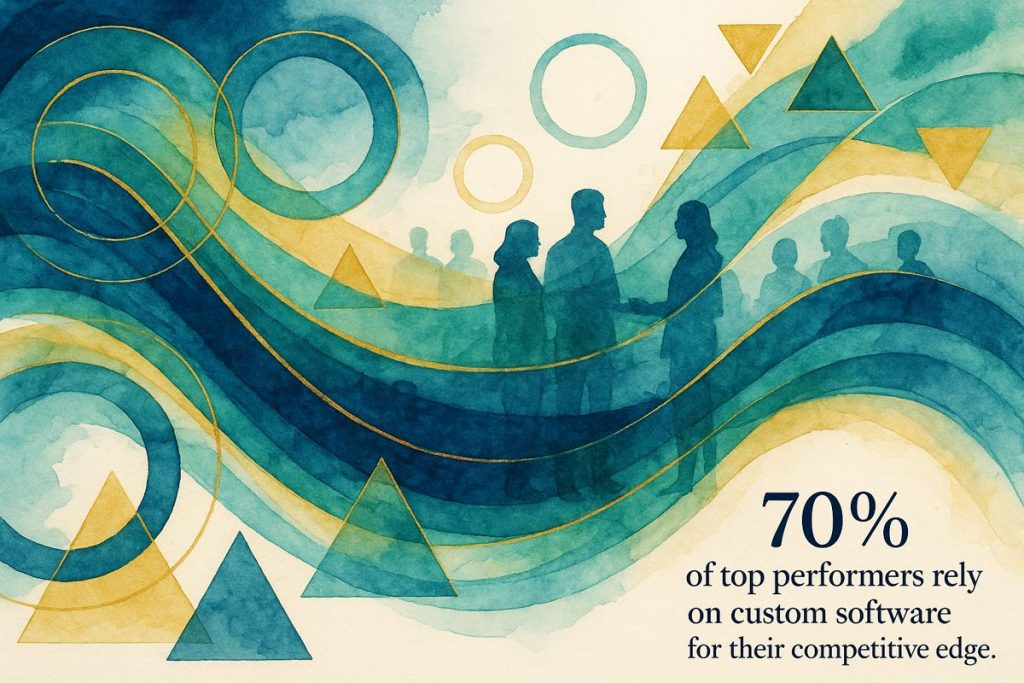Big companies win by using custom software, AI, and smart data tools like secret ingredients in a magic recipe. They build their own tech so they can move faster, stay safe, and do things their way. AI helps them work quicker and smarter, while analytics lets them see problems and chances before anyone else. None of it works without people, so these companies are always learning new skills and mixing old jobs with new tech. In places like pharma and consulting, this digital power is what sets leaders apart from the rest.
How do top companies use custom software, AI, and analytics to achieve business success?
Top companies leverage custom software, AI, and analytics to gain strategic advantages by:
- Building tailored solutions for control, flexibility, and security.
- Automating business functions with AI for faster innovation.
- Using advanced analytics to optimize operations and decision-making.
- Fostering a culture of continuous learning and digital transformation.
If you listen closely, you can almost hear the whir of servers and the quiet hum of anticipation in boardrooms worldwide. A recent McKinsey study splashes a fresh coat of clarity on an old truth: the companies winning today’s market have an uncanny knack for wielding custom software, AI, and advanced analytics as if they were wielding Excalibur. No, really—look at life sciences, pharmaceuticals, or the labyrinthine world of professional services. The digital edge these organizations carve out isn’t just window dressing. It’s become the beating heart of their go-to-market bravado, a strategic asset as critical as cash flow or brand equity.
I’ll admit, I used to think custom software was mostly for fussy back-office types—until I watched a pharma client leapfrog their competition by deploying a custom API-first platform in six months flat. That smell? Coffee, and maybe a whiff of ozone from all those overclocked GPUs.
The Custom Code Conundrum: Not Just for the IT Crowd
For decades, software was the janitor—keeping things tidy, moving paperwork from one digital shelf to another. Now, the script’s flipped. According to McKinsey, a jaw-dropping 70% of top economic performers have gone full auteur with proprietary code, making software the director of the show, not the stagehand.
Why bother with custom code when there’s a SaaS buffet out there? Control. Flexibility. The ability to experiment with features using feature flags—a kind of digital choose-your-own-adventure—for a select user cohort, without risking a catastrophic system meltdown. And let’s not forget modular microservices, which scale out faster than you can say Kubernetes, especially when the cloud is your playground.
Security, too, is a big draw. Finance and healthcare firms, haunted by the specter of compliance, use bespoke systems to tune their defenses as precisely as a Stradivarius. And integration? API-first design lets data flow like a well-oiled Rube Goldberg machine, fueling analytics pipelines and cross-team collaboration.
The punchline: Organizations that embrace these tailored architectures see profit jumps between 25% and 95%—not a bad ROI for what started as a “nice-to-have.” (I once doubted those figures—math isn’t my first language—but after sitting through a quarterly review at a biotech client, watching the CFO’s eyes light up, I was a believer. Well, mostly.)
AI and Analytics: The Phantom Limb and the Crystal Ball
Layer on artificial intelligence and advanced analytics, and suddenly business transformation isn’t just jargon—it’s palpable, like the snap of static on a wool sweater. McKinsey’s AI survey says three-quarters of organizations are automating at least one business function with AI. (Generative AI, incidentally, is the new espresso shot—ubiquitous, occasionally jitter-inducing, but impossible to ignore.)
AI is worming its way into product development, transforming it from a stately waltz into a breakneck tango. Product teams use machine learning to iterate at hyperspeed, jettisoning old-school waterfall models for something more adaptive. Go-to-market strategies? Picture CRM systems that don’t just store data but devour it, spitting out predictions and personalized pitches with eerie prescience.
Operations, too, are getting a facelift. Forecasting, supply chain optimization, quality control—these aren’t just buzzwords anymore. Business Insider reports that machine learning is automating logistics so effectively that even a minor glitch stands out like a scratch on a vinyl record.
Once, I tried to automate my own workflow using a homegrown Python script. It crashed—loudly. Embarrassment, followed by reluctant admiration for those who do this at scale.
Talent, Culture, and the Stubbornness of Humans
Of course, shiny platforms alone don’t propel you to the top of the S&P 500—people do. As generative AI matures, every org-chart starts to look a bit like a palimpsest; layers of old and new roles jostling for space. Companies are redrawing lines, merging IT, business, and data science into one collaborative hydra.
Retraining is rampant. AI literacy has become as essential as Excel, and employees are gobbling up new skills. Leadership, meanwhile, is waking up to the need for direct stewardship over AI risk, strategy, and ethics, as outlined in McKinsey’s 2025 report.
Here’s a nugget: Employees are experimenting with generative AI at triple the rate executives realize, according to McKinsey’s “superagency” research. Picture excited whispers, secret Slack channels, and the faint glow of midnight hackathons. It’s thrilling. Also, a little terrifying—who’s steering this ship?
